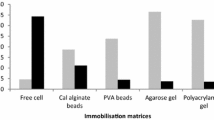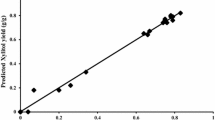Abstract
Xylitol is gaining great attention in current pharmaceutical markets. Commercial production by chemical hydrogenation of xylose is however associated with several inevitable drawbacks. Biotechnological route of xylitol production is a superior alternative, if performed at a lower process costs. The goal of present study was to evaluate the efficiency of bacterial cellulose-sodium alginate (BC-AG) composite as an immobilization matrix for Candida tropicalis GS18 in the production of xylitol through a repeated batch fermentation of rice straw hemicellulosic hydrolysate. Different concentrations of bacterial cellulose, sodium alginate, and calcium chloride were screened to select the stable composite for immobilization. Comparative studies for xylitol production using adsorbed yeast cells on BC-AG composite and suspended cells in different production media like synthetic, non-detoxified, and detoxified hydrolysate were carried out. BC-AG composite prepared by using 3.0% alginate and bacterial cellulose in 1:1 ratio through cross-linking with 3.0% CaCl2 solution was found to be most suitable for cell immobilization. The maximum xylitol yield and productivity obtained from immobilized cells on BC-AG composite in synthetic and detoxified media were 0.67 g/g; 0.70 g/L/h and 0.55 g/g; 0.52 g/L/h, respectively. The composite was successfully used for up to five repeated batch fermentations in synthetic and detoxified hydrolysate media. However, the composite was unstable in the non-detoxified medium. Hence, BC-AG composite was found to be an effective immobilization matrix for bioconversion of xylose into xylitol.



Similar content being viewed by others
References
Benahmed AG, Gasmi A, Arshad M, Shanaida M, Lysiuk R, Peana M, Pshyk- Titko I, Adamiv S, Shanaida Y, Bjørklund G (2020) Health benefits of xylitol. Appl Microbiol Biotechnol 104:7225–7237
Campano C, Balea A, Blanco A, Negro C (2016) Enhancement of the fermentation process and properties of bacterial cellulose: a review. Cellulose 23:57–91
Carvalho W, Silva SSD, Converti A, Vitolo M, Felipe MG, Roberto IC, Silva MB, Mancilha IM (2002) Use of immobilized Candida yeast cells for xylitol production from sugarcane bagasse hydrolysate: cell immobilization conditions. Appl Biochem Biotechnol 98–100:489–496
Costa AFS, Rocha MAV, Sarubbo LA (2017) Bacterial cellulose: an ecofriendly biotextile. Int J Text Fashion Technol 7:11–26
Cunha MAA, Converti A, Santos JC, Ferreira STS, Da Silva SS (2009) PVA-hydrogel entrapped Candida guilliermondii for xylitol production from sugarcane hemicellulose hydrolysate. Appl Biochem Biotechnol 157:527–537
Dasgupta D, Sidana A, Sarkar B, More S, Ghosh D, Bhaskar T, Ray A (2022) Process development for crystalline xylitol production from corncob biomass by Pichia caribbica. Food Bioprod Process. https://doi.org/10.1016/j.fbp.2022.02.006
Ebrahimi F, Sadeghizadeh A, Neysan F, Heydari M (2019) Fabrication of nanofibers using sodium alginate and Poly (Vinyl alcohol) for the removal of Cd2+ ions from aqueous solutions: adsorption mechanism, kinetics and thermodynamics. Heliyon 5(11):e02941
Eş I, Vieira JDG, Amaral AC (2015) Principles, techniques, and applications of biocatalyst immobilization for industrial application. Appl Microbiol Biotechnol 99(5):2065–2082
Gupta R, Hemansi GS, Shukla R, Kuhad RC (2017) Study of charcoal detoxification of acid hydrolysate from corncob and its fermentation to xylitol. J Environ Chem Eng 5(5):4573–4582
Hernández-Pérez AF, de Arruda PV, Sene L, da Silva SS, Chandel AK, de Almeida Felipe MDG (2019) Xylitol bioproduction: state-of-the-art, industrial paradigm shift, and opportunities for integrated biorefineries. Crit Rev Biotechnol 39:924–943
Hernández IP, Pérez-Pimienta JA, Messina S, Saldaña D, Claudia E (2012) Dilute sulfuric acid hydrolysis of tropical region biomass. J Renew Sustain Energy 4(2):021201
Ji L, Zhang F, Zhu L, Jiang J (2021) An in-situ fabrication of bamboo bacterial cellulose/sodium alginate nanocomposite hydrogels as carrier materials for controlled protein drug delivery. Int J Biol Macromol 170:459–468
Jia H, Shao T, Zhong C, Li H, Jiang M, Zhou H, Wei P (2016) Evaluation of xylitol production using corncob hemicellulosic hydrolysate by combining tetrabutylammonium hydroxide extraction with dilute acid hydrolysis. Carbohydr Polym 151:676–683
Kirdponpattara S, Phisalaphong M (2013) Bacterial cellulose–alginate composite sponge as a yeast cell carrier for ethanol production. Biochem Eng J 77:103–109
Krishania M, Kumar V, Sangwan RS (2018) Integrated approach for extraction of xylose, cellulose, lignin and silica from rice straw. Bioresour Technol Reports 1:89–93
Kumar V, Krishania M, Sandhu P, Ahluwalia P, Gnansounou E, Sangwan RS (2017) Efficient detoxification of corn cob hydrolysate with ion-exchange resin for enhanced xylitol production by Candida tropicalis MTCC 6192. Bioresour Technol 251:416–419
Kumar V, Sharma DK, Bansal V, Mehta D, Sangwan RS, Yadav SK (2019) Efficient and economic process for the production of bacterial cellulose from isolated strain of Acetobacterpasteurianus of RSV-4 bacterium. Bioresour Technol 275:430–433
Logeswaran J, Shamsuddin AH, Silitonga AS, Mahlia TMI (2020) Prospect of using rice straw for power generation: a review. Environ Sci Pollut Res 27:25956–25969
López-Linares JC, Romero I, Cara C, Castro E, Mussatto SI (2018) Xylitol production by Debaryomyceshansenii and Candida guilliermondii from rapeseed straw hemicellulosic hydrolysate. Bioresour Technol 247:736–743
Millati R, Wikandari R, Ariyanto T, Putri RU, Taherzadeh MJ (2020) Pretreatment technologies for anaerobic digestion of lignocelluloses and toxic feedstocks. Bioresour Technol 304:122998
Misra S, Raghuwanshi S, Saxena RK (2013) Evaluation of corncob hemicellulosic hydrolysate for xylitol production by adapted strain of Candida tropicalis. Carbohydr Polym 92:1596–1601
Mongkolkajit J, Pullsirisombat J, Limtong S, Phisalaphong M (2011) Alumina-doped alginate gel as a cell carrier for ethanol production in a packed bed bioreactor. Biotechnol Bioprocess 16:505–512
Nemati M, Webb C (2011) Immobilized cell bioreactors. In Comprehensive biotechnology: volume 2: engineering fundamentals of biotechnology. Second Edition edn, vol. 2, Academic Press, Ltd, Burlington, pp. 331–346
Parajó JC, Dominguez H, Dominguez JM (1998) Biotechnological production of xylitol. Bioresour Technol 65:191–201
Pérez-Bibbins B, de Souza Oliveira RP, Torrado A, Aguilar-Uscanga MG, Domínguez JM (2014) Study of the potential of the air lift bioreactor for xylitol production in fed-batch cultures by Debaryomyceshansenii immobilized in alginate beads. Appl Microbiol Biotechnol 98(1):151–161
Prabakaran G, Hoti SL (2008) Immobilization of alginate-encapsulated Bacillus thuringiensis var. israelensis containing different multivalent counterions for mosquito control. Curr Microbiol 57(2):111–114
Prakash G, Varma AJ, Prabhune A, Shouche Y, Rao M (2011) Microbial production of xylitol from d-xylose and sugarcane bagasse hemicellulose using newly isolated thermotolerant yeast Debaryomyceshansenii. Bioresour Technol 102(3):3304–3308
Rafiqul ISM, Sakinah AMM (2013) Processes for the production of xylitol—a review. Food Rev Int 29(2):127–156
Rahman A, Hidayah N, Jamaliah MJ, Munaim A, Sakinah M, Rahman A, Fuzi R, Zaharah SF, Rosli MI (2020) Immobilization of recombinant Escherichia coli on multi-walled carbon nanotubes for xylitol production. Enzyme Microb Technol 135:109495
Rao RS, Jyothi CP, Prakasham RS, Sarma PN, Rao LV (2006) Xylitol production from corn fiber and sugarcane bagasse hydrolysates by Candida tropicalis. Bioresour Technol 97:1974–1978
Santos JC, Mussatto SI, da Cunha MAA, Silva SS (2005) Variables that affect xylitol production from sugarcane bagasse hydrolysate in a zeolite fluidized bed reactor. Biotechnol Prog 21:1639–1643
Shankar K, Kulkarni NS, Sajjanshetty R, Jayalakshmi SK, Sreeramulu K (2020) Co-production of xylitol and ethanol by the fermentation of the lignocellulosic hydrolysates of banana and water hyacinth leaves by individual yeast strains. Ind Crops Prod 155:112809
Singh S, Kaur D, Yadav SK, Krishania M (2020) Process scale-up of an efficient acid-catalyzed steam pretreatment of rice straw for xylitol production by C. tropicalis MTCC 6192. Bioresour Technol 320:124422
Sluiter A, Hames B, Ruiz R, Scarlata C, Sluiter J, Templaton D, Crocker D (2012) Determination of structural carbohydrates and lignin in biomass. Laboratory Analytical Procedure (LAP). Technical Report NREL/TP-510–42618
Soleimani M, Tabil L (2014) Evaluation of biocomposite-based supports for immobilized-cell xylitol production compared with a free-cell system. Biochem Eng J 82:166–173
Solarte-Toro JC, Romero-García JM, Martínez-Patiño JC, Ruiz-Ramos E, Castro-Galiano E, Cardona-Alzate CA (2019) Acid pretreatment of lignocellulosic biomass for energy vectors production: a review focused on operational conditions and techno-economic assessment for bioethanol production. Renew Sustain Energy Rev 107:587–601
Tizazu BZ, Moholkar VS (2018) Kinetic and thermodynamic analysis of dilute acid hydrolysis of sugarcane bagasse. Bioresour Technol 250:197–203
Tizazu BZ, Roy K, Moholkar VS (2018) Ultrasonic enhancement of xylitol production from sugarcane bagasse using immobilized Candida tropicalis MTCC 184. Bioresour Technol 268:247–258
Ur-Rehman S, Mushtaq Z, Zahoor T, Jamil A, Murtaza MA (2015) Xylitol: a review on bioproduction, application, health benefits, and related safety issues. Crit Rev Food Sci Nutr 55(11):1514–1528
Wang L, Jia F, Wu D, Wei Q, Liang Y, Hu Y, Li R, Yu G, Yuan Q, Wang J (2020) In-situ growth of graphene on carbon fibers for enhanced cell immobilization and xylitol fermentation. Appl Surf Sci 527:146793
Wang L, Wu D, Tang P, Fan X, Yuan Q (2012) Xylitol production from corn cob hydrolysate using polyurethane foam with immobilized Candida tropicalis. Carbohydr Polym 90:1106–1113
Webb C, Dervakos GA (1996) Studies in viable cell immobilization. R.G. Landes Company, Georgetown, TX
Yewale T, Panchwagh S, Rajagopalan S, Dhamole PB, Jain R (2016) Enhanced xylitol production using immobilized Candida tropicalis with non-detoxified corn cob hemicellulosic hydrolysate. 3 Biotech 6(1):75
Zahed O, Jouzani GS, Abbasalizadeh S, Khodaiyan F, Tabatabaei M (2015) Continuous co-production of ethanol and xylitol from rice straw hydrolysate in a membrane bioreactor. Folia Microbiol 61:179–189
Zhang Q, Li Y, Xia L, Liu Z (2014) Enhanced xylitol production from statistically optimized fermentation of cotton stalk hydrolysate by immobilized Candida tropicalis. Chem Biochem Eng Q 28(1):87–93
Zhang S, He H, Guan S, Cai B, Li Q, Rong S (2020) Bacterial cellulose-alginate composite beads as Yarrowia lipolytica cell carriers for lactone production. Molecules 25(4):928
Żywicka A, Junka A, Ciecholewska-Juśko D, Migdał P, Czajkowska J, Fijałkowski K (2020) Significant enhancement of citric acid production by Yarrowia lipolytica immobilized in bacterial cellulose-based carrier. J Biotechnol 321:13–22
Acknowledgements
The authors gratefully acknowledge CEO, CIAB, for constant support and encouragement. We also express sincere gratitude to Center of Innovative and Applied Bioprocessing, Mohali (DBT-CIAB), for providing necessary facilities.
Funding
The authors received financial support from Department of Biotechnology, Ministry of Science and Technology, India, under flagship project (BT/CIAB- Flagship/2018).
Author information
Authors and Affiliations
Contributions
Conceptualization: PG, SK, and SKY; methodology: PG and SK; formal analysis and investigation: PG, SK, and AS; writing — original draft preparation: PG, SK, and AS; writing — review and editing: SKY; funding acquisition: SKY; supervision: SKY.
Corresponding author
Ethics declarations
Conflict of interest
The authors declare no competing interests.
Additional information
Publisher's Note
Springer Nature remains neutral with regard to jurisdictional claims in published maps and institutional affiliations.
Rights and permissions
About this article
Cite this article
Guleria, P., Kaur, S., Sidana, A. et al. Xylitol production from rice straw hemicellulosic hydrolysate by Candida tropicalis GS18 immobilized on bacterial cellulose-sodium alginate matrix. Biomass Conv. Bioref. 14, 9241–9251 (2024). https://doi.org/10.1007/s13399-022-02986-0
Received:
Revised:
Accepted:
Published:
Issue Date:
DOI: https://doi.org/10.1007/s13399-022-02986-0




